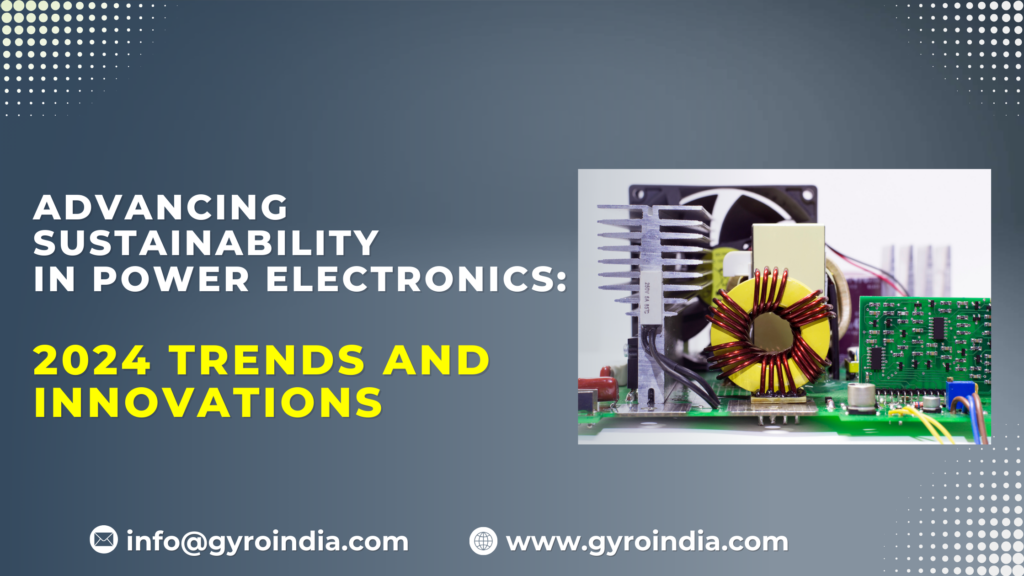Advancing Sustainability in Power Electronics: 2024 Trends and Innovations
 Power electronics are at the heart of sustainable technology, making crucial contributions to cleaner, more efficient energy systems worldwide. In 2024, the industry is seeing exciting trends in power electronics innovation focused on green design, advanced materials, and higher efficiency standards. Let’s explore some of these developments and how they’re shaping a more sustainable future.
Power electronics are at the heart of sustainable technology, making crucial contributions to cleaner, more efficient energy systems worldwide. In 2024, the industry is seeing exciting trends in power electronics innovation focused on green design, advanced materials, and higher efficiency standards. Let’s explore some of these developments and how they’re shaping a more sustainable future.
1. Optimizing Efficiency with Advanced Materials
The drive for efficiency has brought cutting-edge materials like gallium nitride (GaN) and silicon carbide (SiC) into the spotlight. These materials allow power converters and inverters to operate at higher temperatures, voltages, and frequencies, reducing energy loss and lowering cooling needs. As a result, systems are not only more efficient but also smaller and more robust. By using these high-performance materials, the power electronics sector is minimizing its environmental impact while enhancing device performance and longevity. This material evolution is significant for industries like electric vehicles (EVs) and renewable energy, where efficiency is paramount.
2. Modular and Upgradeable Designs to Combat E-Waste
With the rapid evolution of power electronics, many devices quickly become outdated, contributing to the global e-waste challenge. To tackle this, engineers are increasingly adopting modular designs that allow users to upgrade specific components rather than replacing entire systems. This approach reduces electronic waste, as users can easily swap in new parts without discarding the full device. Furthermore, modular systems often improve repairability and enable longer lifespans for electronics. By promoting a circular economy and extending the life of electronic products, this modularity is reshaping sustainable electronics design and creating a positive impact on e-waste reduction.
3. Eco-Friendly Manufacturing Processes
As awareness grows about the environmental impact of industrial production, sustainable manufacturing has become a priority. In power electronics, additive manufacturing (3D printing) is emerging as a valuable approach for creating complex components with minimal waste. By producing only what’s needed and reducing scrap materials, these techniques contribute to more efficient resource use. Additionally, many manufacturers are transitioning to renewable energy sources to power their facilities, lowering the carbon footprint associated with production. Eco-friendly manufacturing helps power electronics manufacturers meet sustainability goals and align with global environmental standards, while also appealing to conscious consumers and stakeholders.
4. Enhanced Energy Storage Integration
Energy storage is a critical component of renewable energy systems, as it enables energy to be stored for later use. Power electronics technologies, such as converters and inverters, are essential in maximizing the efficiency of energy storage systems by minimizing energy loss during the conversion process. Advances in battery technology, combined with sophisticated power electronics, allow for more effective storage solutions. This development is especially crucial for applications in renewable energy, where energy must be stored reliably and used on demand. Efficient energy storage also supports grid stability and helps balance supply with fluctuating demand, a key factor in the transition to cleaner energy sources.
5. Innovations in Electric Vehicle (EV) Power Management
Electric vehicles are a major focus area for power electronics innovation, given the increasing demand for efficient, compact, and high-performing EV systems. In 2024, new power management solutions are helping EVs charge faster, travel longer distances, and deliver superior performance. The integration of advanced power electronics enables better battery utilization and regenerative braking, which reduces energy waste. Moreover, the use of GaN and SiC in EV chargers is cutting charging times and improving energy efficiency, making EVs more convenient and sustainable for consumers.
6. Energy Recovery in Industrial Applications
Many industries, from manufacturing to data centers, are recognizing the importance of energy recovery systems. Power electronics allow for energy generated during processes—such as braking or excess heat generation—to be captured and reused. For instance, regenerative braking in industrial machinery harnesses energy that would otherwise be lost, redirecting it for use within the system or even feeding it back into the grid. This capability reduces overall energy consumption and offers companies significant cost savings, making industrial operations both more sustainable and economically viable.
Why Magnet Free Matters: Revolutionizing Electric Motors for a Sustainable Future

Leave a Reply